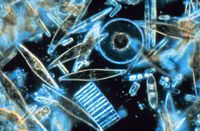
Photo from wikipedia
The so-called "complex" plastids from diatoms possessing four envelope membranes are a typical feature of algae that arose from secondary endosymbiosis. Studying isolated plastids from these algae may allow answering… Click to show full abstract
The so-called "complex" plastids from diatoms possessing four envelope membranes are a typical feature of algae that arose from secondary endosymbiosis. Studying isolated plastids from these algae may allow answering a number of fundamental questions regarding diatom photosynthesis and plastid functionality. Due to their complex architecture and their integration into the cellular endoplasmic reticulum (ER) system, their isolation though is still challenging. In this work, we report a reliable isolation technique that is applicable for the two model diatoms Thalassiosira pseudonana and Phaeodactylum tricornutum. The resulting plastid-enriched fractions are of homogenous quality, almost free from cellular contaminants, and feature structurally intact thylakoids that are capable to perform oxygenic photosynthesis, though in most cases they seem to lack most of the stromal components as well as plastid envelopes.
Journal Title: Methods in molecular biology
Year Published: 2018
Link to full text (if available)
Share on Social Media: Sign Up to like & get
recommendations!